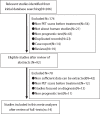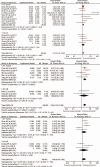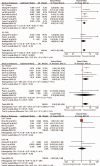Prognostic value of pretreatment 18F-FDG PET-CT for nasopharyngeal carcinoma patients
- PMID: 28445287
- PMCID: PMC5413252
- DOI: 10.1097/MD.0000000000006721
Prognostic value of pretreatment 18F-FDG PET-CT for nasopharyngeal carcinoma patients
Abstract
Background: Nasopharyngeal carcinoma (NPC) is a special subtype of head and neck cancer (HNC). At present, there are no highly specific prognostic markers to aid in tumor grading and guide patient treatment modalities for NPC. The prognostic value of pretreatment F-fluorodeoxyglucose positron emission tomography-computed tomography (F-PET-CT) in NPC patients is controversial and no consensus exists as to its predictive capability.
Methods: To analyze the predictive efficacy of F-PET-CT imaging in NPC patients, data from MEDLINE, EMBASE, the Cochrane library, CBM, CNKI, and VIP (inception to July 2016) were accessed. Results from prospective and retrospective observational studies that used F-FDG PET to predict disease prognosis in NPC patients were used for analysis. Two authors independently assessed study quality and extracted data. Event-free survival (EFS) was considered the primary endpoint and overall survival rate (OS) was considered the secondary endpoint.
Results: Data from 14 studies and 1134 patients were included in our analysis. The hazard ratios (HRs) of maximum standardized uptake value of primary tumor (SUVmax-T), metabolic tumor volume of primary tumor (MTV-T), and total lesional glycolysis of primary tumor (TLG-T) for EFS were 1.31 (95% confidence interval [CI], 1.11-1.55, P = .001), 2.38 (95% CI 1.53-3.70, P < .001), and 1.65 (95% CI 0.76-3.59, P = .21), respectively. Among studies including TLG-T, those with a fixed SUV of 2.5 had an HR of 3.55 (95% CI, 1.42-8.84, P = .007). The HRs of SUVmax-T and MTV-T for OS were 2.19 (95% CI, 1.47-3.27, P < .001) and 2.69 (95% CI, 1.01-7.17, P = .05), respectively. Among studies including MTV-T, those with a fixed SUV of 2.5 had an HR of 4.07 (95% CI, 2.22-7.46, P < .001). Tests used for assessing predictive value of pretreatment SUVmax, MTV, and TLG of lymph nodes for EFS and OS showed that these parameters did not have significant predictive value (P>.05).
Conclusion: Our results suggested that SUVmax, MTV, and TLG (with a fixed SUV of 2.5) of primary tumors before treatment initiation may be independent prognostic factors for NPC patients; however, SUVmax, MTV, and TLG of metastatic lymph nodes are not.
Conflict of interest statement
The authors have no conflicts of interest to disclose.
Figures



Similar articles
-
Prognostic value of baseline [18F]-fluorodeoxyglucose positron emission tomography parameters MTV, TLG and asphericity in an international multicenter cohort of nasopharyngeal carcinoma patients.PLoS One. 2020 Jul 30;15(7):e0236841. doi: 10.1371/journal.pone.0236841. eCollection 2020. PLoS One. 2020. PMID: 32730364 Free PMC article.
-
Prognostic utility of (18)F-FDG PET-CT performed prior to and during primary radiotherapy for nasopharyngeal carcinoma: Index node is a useful prognostic imaging biomarker site.Radiother Oncol. 2016 Jul;120(1):87-91. doi: 10.1016/j.radonc.2016.05.021. Epub 2016 Jun 16. Radiother Oncol. 2016. PMID: 27321151
-
Prognostic value of 18F-FDG-PET/CT in patients with nasopharyngeal carcinoma: a systematic review and meta-analysis.Oncotarget. 2017 May 16;8(20):33884-33896. doi: 10.18632/oncotarget.13934. Oncotarget. 2017. PMID: 27980228 Free PMC article.
-
Prognostic value of maximum standard uptake value, metabolic tumor volume, and total lesion glycolysis of positron emission tomography/computed tomography in patients with nasopharyngeal carcinoma: A systematic review and meta-analysis.Medicine (Baltimore). 2017 Sep;96(37):e8084. doi: 10.1097/MD.0000000000008084. Medicine (Baltimore). 2017. PMID: 28906411 Free PMC article.
-
Prognostic value of 18F-FDG-PET/CT parameters in patients with pancreatic carcinoma: A systematic review and meta-analysis.Medicine (Baltimore). 2017 Aug;96(33):e7813. doi: 10.1097/MD.0000000000007813. Medicine (Baltimore). 2017. PMID: 28816978 Free PMC article.
Cited by
-
Prognostic significance of metabolic tumour volume and maximum standard uptake value of fluor-18-fluorodeoxyglucose positron emission tomography with computed tomography in nasopharyngeal carcinoma.Contemp Oncol (Pozn). 2021;25(3):153-159. doi: 10.5114/wo.2021.109620. Epub 2021 Oct 1. Contemp Oncol (Pozn). 2021. PMID: 34729034 Free PMC article.
-
Prospective evaluation of plasma Epstein-Barr virus DNA clearance and fluorodeoxyglucose positron emission scan in assessing early response to chemotherapy in patients with advanced or recurrent nasopharyngeal carcinoma.Br J Cancer. 2018 Apr;118(8):1051-1055. doi: 10.1038/s41416-018-0026-9. Epub 2018 Mar 20. Br J Cancer. 2018. PMID: 29555989 Free PMC article. Clinical Trial.
-
Predictive value of 18F-FDG PET/CT for evaluating the response to hypofractionated radiotherapy combined with PD-1 blockade in non-small cell lung cancer.Front Immunol. 2023 Feb 13;14:1034416. doi: 10.3389/fimmu.2023.1034416. eCollection 2023. Front Immunol. 2023. PMID: 36860861 Free PMC article.
-
Radiomics in Nasopharyngeal Carcinoma.Clin Med Insights Oncol. 2022 Feb 24;16:11795549221079186. doi: 10.1177/11795549221079186. eCollection 2022. Clin Med Insights Oncol. 2022. PMID: 35237090 Free PMC article. Review.
-
A convolutional neural network with self-attention for fully automated metabolic tumor volume delineation of head and neck cancer in F]FDG PET/CT.Eur J Nucl Med Mol Imaging. 2023 Jul;50(9):2751-2766. doi: 10.1007/s00259-023-06197-1. Epub 2023 Apr 20. Eur J Nucl Med Mol Imaging. 2023. PMID: 37079128 Free PMC article.
References
-
- Bruce JP, Yip K, Bratman SV, et al. Nasopharyngeal cancer: molecular landscape. J Clin Oncol 2015;33:3346–55. - PubMed
-
- Aribas BK, Cetindag F, Ozdogan Z, et al. Nasopharyngeal carcinomas: prognostic factors and treatment features. J Egypt Natl Canc Inst 2008;20:230–6. - PubMed
-
- Liu WS, Wu MF, Tseng HC, et al. The role of pretreatment FDG-PET in nasopharyngeal carcinoma treated with intensity-modulated radiotherapy. Int J Radiat Oncol Biol Phys 2012;82:561–6. - PubMed
-
- Chan SC, Chang JT, Wang HM, et al. Prediction for distant failure in patients with stage M0 nasopharyngeal carcinoma: the role of standardized uptake value. Oral Oncol 2009;45:52–8. - PubMed
Publication types
MeSH terms
Substances
LinkOut - more resources
Full Text Sources
Other Literature Sources

